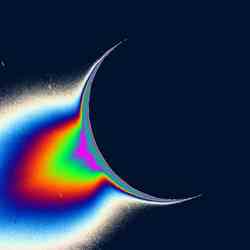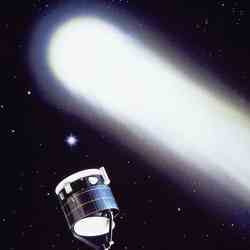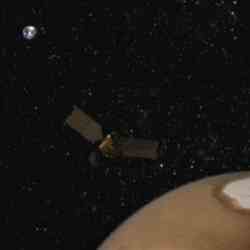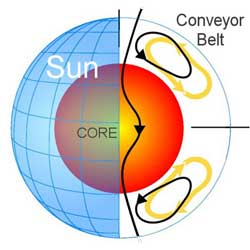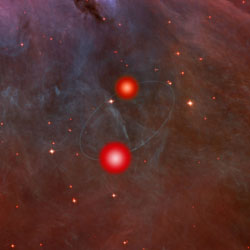
Artist illustration of brown dwarf binary pair. Image credit: Hubble. Click to enlarge.
One of the most difficult tasks for astronomers is to figure out how massive distant objects are. Once you find objects orbiting one another; however, it’s relatively easy to do. The Hubble Space Telescope has helped astronomers measure the mass of a binary pair of brown dwarfs – failed stars – as they orbit one another. One dwarf is 55 times the mass of Jupiter, and the other is 35 times the mass. Each would have to be 80 times the mass of Jupiter before they had enough mass to ignite a fusion reaction.
For the first time, astronomers have succeeded in weighing a binary pair of brown dwarfs and precisely measuring their diameters. These kinds of exact measurements are not possible when observing a single brown dwarf.
Because their orbits are inclined edge-on to Earth, the dwarfs pass in front of each other, creating eclipses. This is the first brown dwarf-eclipsing binary ever discovered. The pair offers an unusual opportunity for accurately determining the masses and diameters of the dwarfs, providing crucial tests of theoretical models.
A brown dwarf is a little understood intermediate class of celestial object that is too small to sustain hydrogen fusion reactions, like those that power our Sun. However, brown dwarfs are dozens of times more massive than the Solar System’s largest planet, Jupiter, and so are too large to be a planet.
The discovery of the paired brown dwarfs and the critical measurements are reported today in the scientific journal Nature by a team of astronomers: Jeff Valenti of the Space Telescope Science Institute (STScI), Robert Mathieu of the University of Wisconsin-Madison, and Keivan Stassun of Vanderbilt University.
One dwarf is 55 times Jupiter’s mass; the other is 35 times heftier than Jupiter (with a 10 percent margin of error). To qualify as a star and burn hydrogen through nuclear fusion, the dwarfs would have to be 80 times more massive than Jupiter. For comparison, the Sun is 1,000 times more massive than Jupiter.
The astronomers are surprised to discover that the more massive brown dwarf is the cooler of the pair, contrary to all predictions about brown dwarfs of the same age. Either the two are not the same age and may be captured bodies, or the theoretical models are wrong, say researchers.
The brown dwarf pair orbits each other so closely that they look like a single object when viewed from Earth. Because their racetrack orbit is edge-on, the two objects periodically pass in front of, or eclipse, each other. These eclipses cause regular dips in the brightness of the combined light coming from both objects. By precisely timing these occultations the astronomers were able to determine the orbits of the two objects. With this information, the astronomers used Newton’s laws of motion to calculate the mass of the two dwarfs.
In addition, the astronomers calculated the size of the two dwarfs by measuring the duration of the dips in their light curve. Because they are so young, the dwarfs are remarkably large for their mass: about the same diameter as the Sun. Because the pair is located in the Orion Nebula, which is a nearby stellar nursery with stars less than 10 million years old.
An analysis of the light coming from the dwarf pair indicates that the dwarfs have a reddish cast. Current models also predict that brown dwarfs should have “weather” — cloud-like bands and spots similar to those visible on Jupiter and Saturn.
By measuring variations in the light spectrum coming from the pair, the astronomers also determined the dwarfs’ surface temperatures. Theory predicts that the more massive member of a pair of brown dwarfs should have a higher surface temperature. But they found just the opposite. The heavier of the two has a temperature of 4,310 degrees Fahrenheit (2,650 degrees Kelvin) and the smaller, 4,562 degrees F (2,790 degrees K). These compare to the Sun’s surface temperature of 9,980 degrees F (5,800 degrees K).
“One possible explanation is that the two objects have different origins and ages,” Stassun says. If that is the case, then it supports one of the outcomes of the latest efforts to simulate the star-formation process. These simulations predict that brown dwarfs are created so close together that they are likely to disrupt each other’s formation.
The new observations confirm the theoretical prediction that brown dwarfs start out as star-sized objects, but shrink and cool and become increasingly planet-sized as they age. Before now, the only brown dwarf whose mass had been directly measured was much older and dimmer.
Many astronomers think that brown dwarfs may actually be the most common product of the stellar-formation process. So, information about brown dwarfs can provide valuable new insights into the dynamic processes that produce stars out of collapsing whirlpools of interstellar dust and gas.
Because old brown dwarfs are smaller and dimmer than true stars, it is only in recent years that improvements in telescope technology have allowed astronomers to catalog hundreds of faint objects that they think may be brown dwarfs. But to pick out the brown dwarfs from other types of faint objects, they need a way to estimate their masses, because mass is destiny for stars and star-like objects.
The existence of brown dwarfs was first proposed in the 1980s, but it wasn’t until 2000 that a brown dwarf was detected unambiguously. While brown dwarfs were hypothetical objects, astronomers differentiated them from planets by the manner in which they formed. Brown dwarfs and stars are formed in the same way, from a collapsing cloud of interstellar dust and gas. Planets are built from the disks of dust and gas that surround forming stars. Once astronomers discovered the first candidate brown dwarf, they realized that dwarfs are very difficult to differentiate from planets, particularly when they have stellar companions. So a growing group of astronomers favor defining brown dwarfs as objects between 13 to 80 times more massive than Jupiter.
The researchers made the observations with two sets of telescopes located in the Chilean Andes, about 100 miles north of Santiago: the Small and Moderate Aperture Research Telescope System (SMARTS), operated by a consortium including the Space Telescope Science Institute and Vanderbilt University, and the International Gemini Observatory, operated by the National Science Foundation.
Original Source: Hubble News Release





